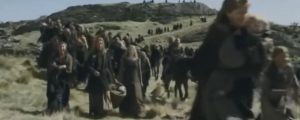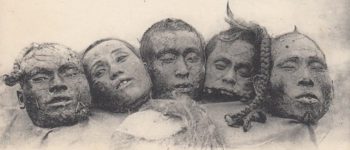1700: The First Christchurch Gondola
July 19, 2020
By AHNZ

On 24 October, 1992, The Mt Cavendish Gondola was open for business and is still running today under the name Christchurch Gondola. You can be seated in a gondola basket on a return trip to visit the cafe at the top and take in amazing views. What few realise is that this was not the first Christchurch gondola. The local Maori, Ngai Tahu, first established one in about the year 1700.
“Legend has it that the Ngai Tahu conquered the Ngati Mamoe in bloody battle…legend is supported by the Maori name for the rocky heights above Lyttelton: O-kete-upoko means “place of the basket of heads”, which is said to refer to the triumph of the Ngai tahu chieftain Rangi Whakaputa who decorated the outcrop with the heads of the conquered Ngati Mamoe.” – Summit Road Society
“To make sure the remaining Ngati Mamoe understood the message that the Ngai Tahu were the new bosses in town, Te Rangi-whakaputa cut off a few of the dead warriors heads and placed them in a flax basket. He carried them up to the top of Mount Cavendish and placed them on the highest mount. Here he made them an offering to the Ngai Tahu’s god of war. As he towered over the bay that would become the port of Lyttelton, he said his offering was ‘he kai mo t era, mo te manu’ – food for the sun and for the birds.”- DISCO
That’s right, the first visitors’ gondolas were flax baskets and the first to ride them did so involuntarily. There was a view and a cafe at the top back then too but…it was for the scavenging birds.
 Ngai Tahu colonised the previous people to hold the South Island, Ngati Mamoe who got there by doing the same to the people before themselves, The Waitaha. Ngai Tahu themselves were subsequently repelled by Ngati Toa and friends but under the protection of the new tribe in charge, the British, crept back northwards where they claim to be tangata whenua, the ‘people of the land.’ Some of the refugees (who had kept their heads) fled to join the Moriori of the Chatham Islands¹, a place they could be safe but only for the next century or so.
Ngai Tahu colonised the previous people to hold the South Island, Ngati Mamoe who got there by doing the same to the people before themselves, The Waitaha. Ngai Tahu themselves were subsequently repelled by Ngati Toa and friends but under the protection of the new tribe in charge, the British, crept back northwards where they claim to be tangata whenua, the ‘people of the land.’ Some of the refugees (who had kept their heads) fled to join the Moriori of the Chatham Islands¹, a place they could be safe but only for the next century or so.
“It means “The Place of the Basket of Heads.” A sufficiently grim name this, remindful of the Whanga-raupo’s red and cannibal past, for the heads were human ones. When the olden warrior Te Rangi-whakaputa set out to make the shore of the Raupo Harbour his own, he encountered numerous parties of Ngati-Mantoe, who put up a fight for their homes and hunting-grounds. One of these parties of the tangata-whenua, the people of the land, he met in battle on the rocky beach of Ohinehou where the white man’s breakwaters and wharves now stand. He worsted them, and the heads of the slain he and his followers hacked off with their stone patus and axes. Some, those of the chief men, Te Rangi-whakaputa placed in a flax basket, and, bearing them up to the craggy hill-crest that towered above the beach, he set them down on a lofty pinnacle, an offering to his god of battles. There they were left, say the Maoris, he kai mo te ra, mo te manu- “food for the sun and for the birds.” “O” signified “the place of,” “kete” basket and “upoko” head, and thus was the place named, to memorise the tattooed brown conqueror of old and the ancient people whom he dispossessed on the shores of the Whangaraupo.”- Cowan (1923)
Mt Cavindish is a better name and reputation for this peak than the nasty old Oteteupoko. We don’t even know what the dispossessed Ngati Mamoe called the peak. Wordplay was part of how pre-colonial Maoris waged war on each other and a similar trick would be played on Ngai Tahu in due course by the Ngati Toa: They re-named the Ngai Tahu capital, Kaiapoi, thusly: ‘Piling up bodies to eat them’. (Ref. 1832: Operation Barracuda Tooth)
Even though the summit buildings that receive the Christchurch Gondola have a Time Tunnel teaching visitors the local history, they make no mention of the Oteteupoko slaughter. But perhaps that’s about to change?
Black Lives Matter
 The Mt Cavindish Time Tunnel came under attack this week by a Black Lives Matter activist, Anahera Clarkson.
The Mt Cavindish Time Tunnel came under attack this week by a Black Lives Matter activist, Anahera Clarkson.
If you were to assume the usual stereotype of a Black Lives Matter person you wouldn’t be far wrong. (ie Part-time Maori language teacher solo mother candle-pyramid scheme peddler black-immigrant-boyfriended white woman identifying as a Maori covered in makeup and nose piercings².) But let’s not do what the Identitarians do and judge people by their affiliations but by their arguments..
“super offensive”
“It was like colonisation was a positive thing for New Zealand.
“I could literally feel my tīpuna [ancestors] and their disappointment.”
“She wanted the company to close the ride until it could present a more accurate and balanced representation of Māori.”- Offensive’ Christchurch Gondola time tunnel attraction mispronounces te reo, ‘celebrates’ colonialism; Stuff (18 July 2020)
Being Offended is about all it takes these days to make national headlines. One woman from out-of-town can make a story because of her “super” feelings. Especially if you can “literally” feel the emotions of the dead.
Funny how Anahera was attuned to Ngai Tahu ghosts’ disappointment but her mountain seance didn’t include the pain and genocide the wailing Ngati Mamoe spirits.
Funny how Anahera lashes out at the peaceful colonisation of the Cantabrians but not that of the Ngai Tahu who violently scattered or desecrated or ate the tangata-whenua to be where they are today.
Funny how ‘Black Lives Matter’ but not until Western Civilisation was established. They sure didn’t matter to the Ngai Tahu!
It’s not Politically Correct to contradict such nonsense, and especially not to argue that British colonisation *was* a positive thing for New Zealand in general and for this mountain in particular.
Tell It How It Is. No More Depicting the Colonisers as the Hero’s
🤟🏽 Not for that white-washed version of our history! Tell it how it is. Colonisation is nothing to be celebrated. I guess the reporter knew I’d get some backlash – the things I have said in this article were probably the more article friendly things that I had said 🤣 No more depicting the colonisers as the hero’s 🤐 no more depicting US as primitive-like cave-men and STOP exploiting our culture for money when you can’t or don’t even have the decency to try to pronounce our kupu correctly!
Ka whawhai tonu mātou AKE AKE! ✊🏾❤️🤍🖤
– Anahera Clarkson; Facebook
 Of course, the Time Tunnel will fold the same way Canterbury Museum and Canterbury Crusaders submitted to Cancel Culture. Non-Government dialects and accents are too diverse and need to be eradicated so we may have a more diverse society. Pronunciations such as “Marry” for Māori (instead of ‘Moldy’) or “kee-oar-ra” for “Kia ora” are part of what Cancel Culture seeks to Colonise but when they do it it’s ‘Decolonising’!
Of course, the Time Tunnel will fold the same way Canterbury Museum and Canterbury Crusaders submitted to Cancel Culture. Non-Government dialects and accents are too diverse and need to be eradicated so we may have a more diverse society. Pronunciations such as “Marry” for Māori (instead of ‘Moldy’) or “kee-oar-ra” for “Kia ora” are part of what Cancel Culture seeks to Colonise but when they do it it’s ‘Decolonising’!
This wave of Victimhood Culture will end soon. It’s just a matter of how many of our museums, words, icons, statues etc will survive the iconoclasm.
I’d quite like it if Anahera Clarkson’s offence wishes were fulfilled an the Time Tunnel really did “present a more accurate and balanced representation of Maori.” Would she be asking for this if she knew? Imagine having as part of the time tunnel the accurate and balanced account of what really happened at this locality! Severed heads and all!
—
1 Ref. “Tradition preserved by the Morioris of the Chatham Islands records that a people from Banks Peninsula came in their midst, and were welcomed…”; Lore and History of the South Island Maori; Taylor (1950); nzetc.victoria.ac.nz
2 Of course, the Wokepaper doesn’t mention any of these political motivations for Clarkson’s attack or her activism. She’s just a regular Mom taking her child out for a day trip when the mean old colonial tourist venture leapt out and offended her.
Ref. A PLACE OF THE BASKET OF HEADS; Discover the Delights of Pealing Back History
Ref. THE CHRISTCHURCH GONDOLA OPENED – 24TH OCTOBER 1992; Discover the Delights of Pealing Back History
Ref. Maori Folk Tales of the Port Hills, James Cowan (1923); State Library of Victoria
Image ref. Postcard of severed heads of Vietnamese “pirates” in 1880s French Indochina, “Pirates, highwaymen or resistance against colonization were hunted down by the French army, killed in fighting, imprisoned, tried, condemned or executed. The executions were carried out according to the rite of the Annamese law, law of the country, by beheading.”; INDOCHINA old postcards
Note: British New Zealand had native rebels like these too in the 1880s. Not for nothing that the Maoris preferred British Colonialism over French!
 Like Comment Share
Like Comment Share





